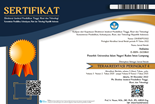Organizational Commitment: Developing a Valid and Reliable Measuring Instrument
Abstract
Keywords: Organizational Commitment, Psychological Scale, Measuring Instrument
Full Text:
PDFReferences
Ardana, I. K., Mujiati, N. W., & Utama, I. W. M. (2013). Manajemen Sumber Daya Manusia. Graha Ilmu, 53(9), 1689–1699.
Arikunto, S. (2010). Prosedur Penelitian: Suatu Pendekatan Praktik. Jakarta: Rineka Cipta.
Azwar, S. (2012). Reliabilitas dan Validitas. Edisi 4. Yogyakarta: Pustaka Pelajar
Azwar, S. (2013). Penyusunan Skala Psikologi. Yogyakarta: Pustaka Pelajar
Bangun, W. (2012). Manajemen Sumber Daya Manusia. Jakarta: Penerbit Airlangga.
Ingarianti, T. M. (2017). Faktor-Faktor Yang Mempengaruhi Komitmen Karier. Jurnal Ilmiah Psikologi Terapan, 5(2), 202–209. https://doi.org/10.22219/jipt.v5i2.4935
Mathieu, C., Fabi, B., Lacoursière, R., & Raymond, L. (2015). The role of supervisory behavior, job satisfaction and organizational commitment on employee turnover. Journal of Management and Organization, 22(1), 113–129. https://doi.org/10.1017/jmo.2015.25
Meyer, J, P., & Allen, N, J. (1991) A Three-Component Conceptualization Of Organization Commitment. Human Resource Management Review: ScienceDirect. 1(1), 61-89.
Muhid, A., Suhadiyanto, & Nurhidayat, D. (2015). Pengembangan alat ukur psikologi. Metodologi Penelitian Kesehatan, 2008(November), 1–10.
Newstrom, J, W. (2011). organizational Behavior, Human Behavior at Work. McGraw-Hill Companies, New York
Nurandini, A, & Lataruva, E. (2014). Analisis Pengaruh Komitmen Organidsasi Terhadap Kinerja Karyawan (Studi Pada Pegawai Perum Perumnas Jakarta). Jurnal Studi Manajemen & Organisasi, 11, 78–91. http://ejournal.undip.ac.id/index.php/smo
Pulido-Martos, M., Gartzia, L., Augusto-Landa, J. M., & Lopez-Zafra, E. (2024). Transformational leadership and emotional intelligence: allies in the development of organizational affective commitment from a multilevel perspective and time-lagged data. Review of Managerial Science, 18(8), 2229–2253. https://doi.org/10.1007/s11846-023-00684-3
Retnowati, E., & Masnawati, E. (2024). Pengaruh Dukungan Organisasi Dan Komitmen Organisasi Terhadap Kinerja Karyawan. Jurnal Baruna Horizon, 6(2), 86–94. https://doi.org/10.52310/jbhorizon.v6i2.104
Saputri, A, R., Hajar, I., Rusian, & Nur, M. (2023). Pengaruh Budaya Organisasi Terhadap Kinerja Organisasi. Jurnal Manajemen Bisnis Dan Organisasi, 1(2), 337–340. https://doi.org/10.58290/jmbo.v1i2.71
Sugiyono. (2016). Metode penelitian kuantitatif, kualitatif dan r&d. Bandung: PT Alfabet.
Sugiyono. (2017). Metode Penelitian Pendidikan (Pendekatan Kuantitatif, Kualitatif, dan R&D). Alfabeta, Bandung.
DOI: http://dx.doi.org/10.24042/ajp.v8i1.24002
Refbacks
- There are currently no refbacks.
Copyright (c) 2025 Ulia Arbarehan Imha













